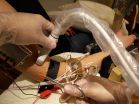(Press-News.org) The human and environmental dangers posed by a widely used manufacturing technique could be almost eradicated thanks to research led by Plymouth University.
Fibre-reinforced polymer matrix composites are painted or sprayed onto products to provide a high-quality finish in transport applications, chemical plants, renewable energy systems and pipelines.
But that finishing process causes the vapours of a volatile organic compound – styrene, found in polyesters and vinyl-esters – to be emitted, posing potential health and wellbeing risks to the workforces involved and the wider environment.
Now a team from Plymouth University, part of the €1.4million InGeCt project funded by the European Union's Framework Programme 7 (FP7) initiative, has identified that in-mould gel-coating could reduce average styrene levels by more than 98% and provide a route to improved workplace conditions and reduced environmental impact.
Dr John Summerscales, Associate Professor in Composites Engineering at Plymouth University, led the study. He said: "Styrene has been the subject of extensive debate in respect of health and environmental issues. Exposure to styrene has previously been linked to altered mood states, in particular aggression, while its vapour has been reported to cause depression, fatigue and a slowing in reaction times. By reducing styrene levels in the workplace, there would be numerous positive results such as improving retention of workforce personnel, minimising release to the environment and reducing odour at the factory boundary."
The European-wide study compared three techniques used in the finishing process – conventional hand-painted gel-coating, in-mould gel-coating with a separator fabric and in-mould surfacing with a silicone shim processes – to establish if styrene levels can be significantly reduced by the adoption of closed mould systems.
The hand-painted technology was found to have significantly higher levels of styrene emission than the two closed mould processes. For the open mould process, the average styrene levels were in the range 28-70 parts per million (ppm).
The two closed mould technologies were shown to significantly reduce the measured styrene levels, to lie in the range 0.23-0.37 ppm, demonstrating a reduction in average styrene emission levels of more than 98%, with obvious benefits for worker health and the reduction of environmental burdens.
Dr Summerscales added: "The occupational exposure limits for styrene currently vary across the European Union, but a recent directive (REACH) is likely to result in the harmonisation of permitted styrene levels – most probably at the current lowest (Scandinavian) level. The recommendation for a 20ppm time-weighted average, which would be an 80% cut in the UK, is unlikely to be achievable with open mould gel-coating. The research we have undertaken aims to keep composites manufacturing within the EU, rather than exporting difficult manufacturing processes to less regulated countries, with subsequent benefits for employment within European nations."
InGeCt was a two-year research collaboration, whose main aim is to develop an innovative environmentally friendly gel-coating technology for composites for marine and wind-turbine applications to reduce VOC emissions, processing time and cost.
INFORMATION:
Led by Plymouth University, it also involved academics and companies across Europe including Alan Harper Composites (Cornwall, UK), Centro Tessile Cotoniero E Abbigliamento SpA (Italy), De IJssel Coatings BV (Netherlands), KMT Nord APS (Denmark), Lightweight Structures BV (Netherlands), SP Technical Research Institute of Sweden (Sweden),Tessitura Valdolona SRL (Italy).
Scientists identify method of eradicating harmful impacts from manufacturing process
2014-10-08
ELSE PRESS RELEASES FROM THIS DATE:
Smallest world record has 'endless possibilities' for bio-nanotechnology
2014-10-08
Scientists from the University of Leeds have taken a crucial step forward in bio-nanotechnology, a field that uses biology to develop new tools for science, technology and medicine.
The new study, published in print today in the journal Nano Letters, demonstrates how stable 'lipid membranes' – the thin 'skin' that surrounds all biological cells – can be applied to synthetic surfaces.
Importantly, the new technique can use these lipid membranes to 'draw' – akin to using them like a biological ink – with a resolution of 6 nanometres (6 billionths ...
Antarctic sea ice reaches new record maximum
2014-10-08
VIDEO:
The Arctic and the Antarctic are regions that have a lot of ice and acts as air conditioners for the Earth system. This year, Antarctic sea ice reached a record...
Click here for more information.
Sea ice surrounding Antarctica reached a new record high extent this year, covering more of the southern oceans than it has since scientists began a long-term satellite record to map sea ice extent in the late 1970s. The upward trend in the Antarctic, however, is only about ...
Neurons in human muscles emphasize the impact of the outside world
2014-10-08
Stretch sensors in our muscles participate in reflexes that serve the subconscious control of posture and movement. According to a new study published in the Journal of Neuroscience, these sensors respond weakly to muscle stretch caused by one's voluntary action, and most strongly to stretch that is imposed by external forces. The ability to reflect causality in this manner can facilitate appropriate reflex control and accurate self-perception.
"The results of the study show that stretch receptors in our muscles indicate more than which limb is moving or how fast; these ...
Treasure trove of ancient genomes helps recalibrate the human evolutionary clock
2014-10-08
Just like adjusting a watch, the key to accurately telling evolutionary time is based upon periodically calibrating against a gold standard.
Scientists have long used DNA data to develop molecular clocks that measure the rate at which DNA changes, i.e., accumulates mutations, as a premiere tool to peer into the past evolutionary timelines for the lineage of a given species. In human evolution, for example, molecular clocks, when combined with fossil evidence, have helped trace the time of the last common ancestor of chimpanzees and humans to 5-7 million years ago, and ...
Gluing chromosomes at the right place
2014-10-08
During cell division, chromosomes acquire a characteristic X-shape with the two DNA molecules (sister chromatids) linked at a central "connection region" that contains highly compacted DNA. It was unknown if rearrangements in this typical X-shape architecture could disrupt the correct separation of chromosomes. A recent study by Raquel Oliveira, from the Instituto Gulbenkian de Ciência (Portugal), in collaboration with colleagues from the University of California, Santa Cruz (USA), now shows that the dislocation of particular DNA segments perturbs proper chromosome ...
Fine-tuning of bitter taste receptors may be key to animal survival
2014-10-08
One key to animal survival is bitter taste----the better to avoid ingesting potentially harmful poisons or foods. The evolution of bitter taste has been a hot topic amongst evolutionary biologists, and with more and more DNA data available, a rich area of exploration.
Now, professor Maik Behrens, et. al. examined the genetic repertoire of bitter taste receptor genes in chickens and frogs, which represent two extremes. Chickens only have 3 bitter taste receptor genes (Tas2rs), while frogs have more than 50 (humans are somewhere in the middle). They studied the different ...
Dietary fat under fire
2014-10-08
This news release is available in French. The association between saturated fat and cardiovascular risk has become a hot topic in nutrition. Researchers at the Institute of nutrition and functional foods (INAF) of Université Laval are calling for a review of dietary recommendations on saturated fat (SFA) in relation to cardiovascular disease (CVD).
In a Comment paper, published today in the journal Applied Physiology, Nutrition, and Metabolism the authors provide a number of arguments for the urgency to re-assess the association between dietary saturated fat ...
Flies with colon cancer help to unravel the genetic keys to disease in humans
2014-10-08
Researchers at the Institute for Research in Biomedicine (IRB Barcelona) have managed to generate a fruit fly (Drosophila melanogaster) model that reproduces human colon cancer. With two publications appearing in PLoS One and EMBO Reports, the IRB team also unveil the function of a key gene in the development of the disease.
"The breakthrough is that we have generated cancer in an adult organism and from stem cells, thus reproducing what happens in most types of human cancer. This model has allowed us to identify subtle interactions in the development of cancer that are ...
Fruit flies reveal features of human intestinal cancer
2014-10-08
HEIDELBERG, 8 October 2014 – Researchers in Spain have determined how a transcription factor known as Mirror regulates tumour-like growth in the intestines of fruit flies. The scientists believe a related system may be at work in humans during the progression of colorectal cancer due to the observation of similar genes and genetic interactions in cultured colorectal cancer cells. The results are reported in the journal EMBO Reports.
Colorectal cancer leads to more than half a million deaths worldwide each year. The disease originates in the epithelial cells of the ...
Supervisors' abuse, regardless of intent, can make employees behave poorly
2014-10-08
SAN FRANCISCO, Oct. 8, 2014 -- Employees who are verbally abused by supervisors are more likely to "act out" at work, doing everything from taking a too-long lunch break to stealing, according to a new study led by a San Francisco State University organizational psychologist.
Even if the abuse is meant to be motivational -- like when a football coach berates his team or a drill sergeant shames her cadets -- the abused employees are still more likely to engage in counter-productive work behaviors, said Kevin Eschleman, assistant professor of psychology at SF State.
The ...





